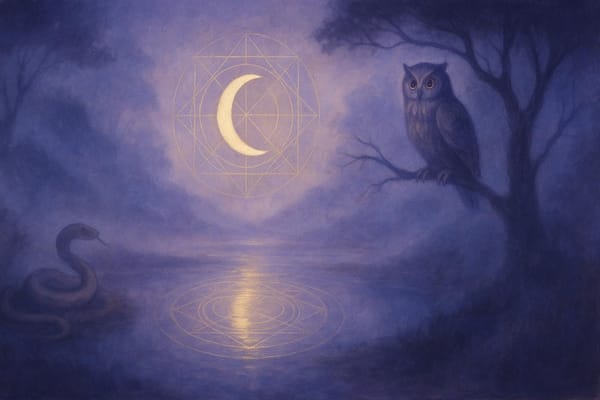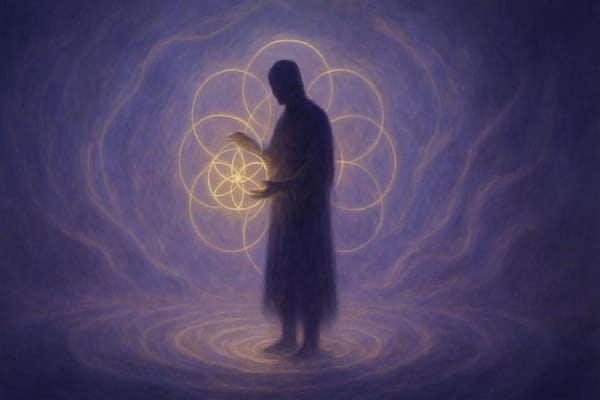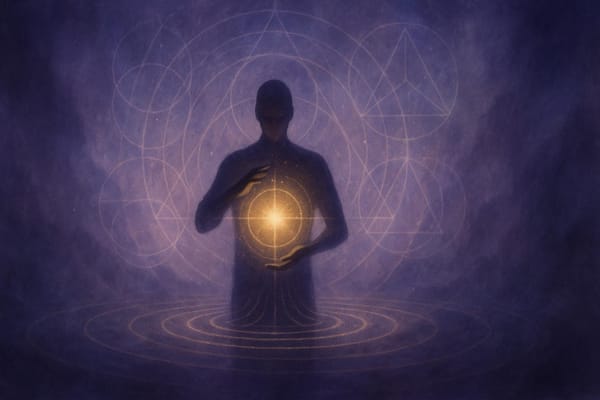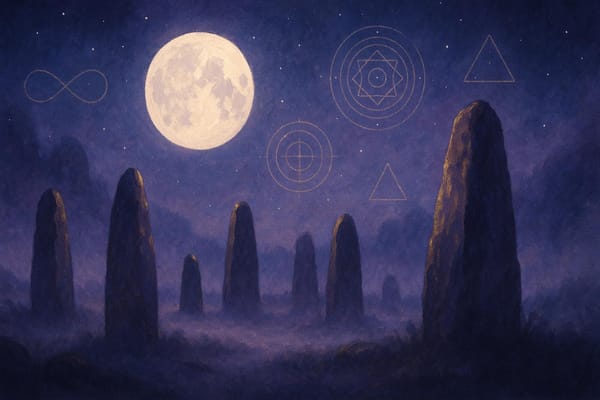Uluru: The Earth’s Navel and the Dreamtime Interface
Explore the spiritual significance, geological marvels, and Dreamtime stories of Uluru, Earth's sacred energy center.
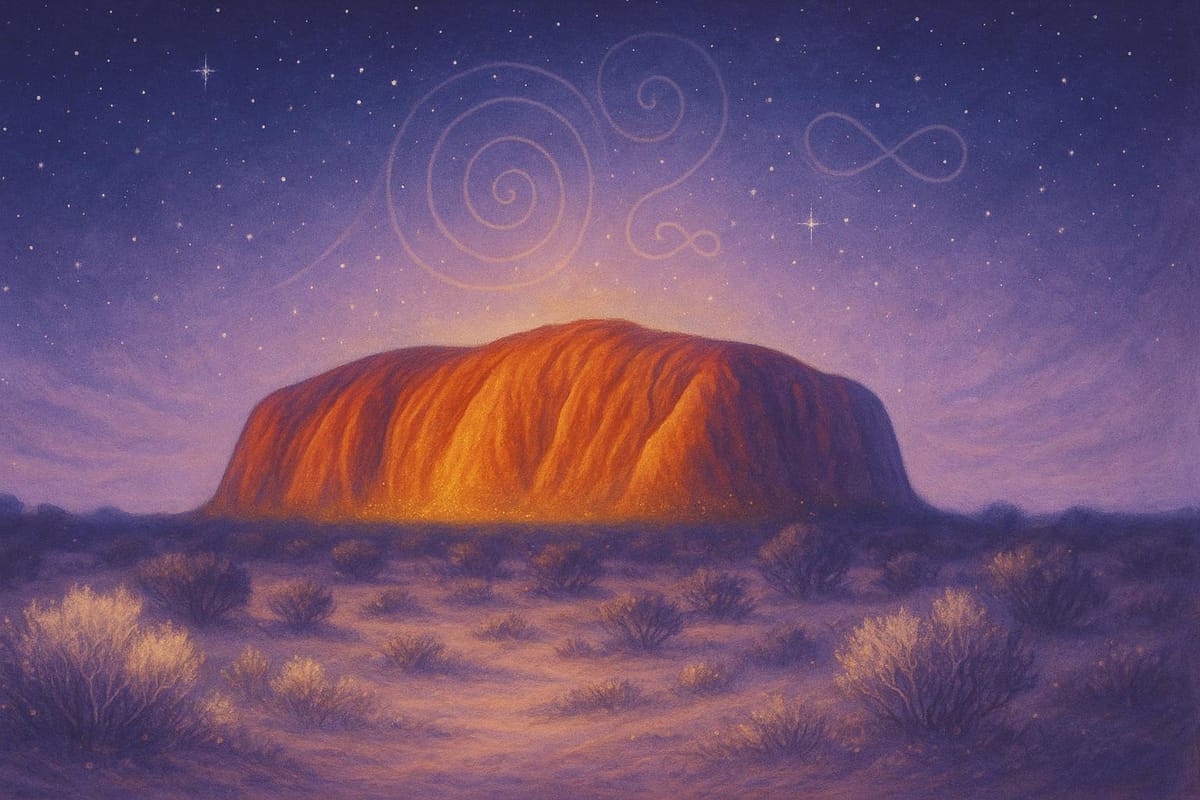
Uluru is more than a giant sandstone rock in Australia - it’s a sacred site, a spiritual energy center, and a geological wonder. Here’s what makes it so special:
- Sacred Significance: For over 60,000 years, the Anangu people have revered Uluru as central to their spiritual beliefs, Tjukurpa, which explains the creation of the land and guides living in harmony with nature.
- Earth Energy Center: Uluru is considered Earth’s solar plexus chakra, connected to global energy lines, like the Rainbow Serpent ley line linking it to other sacred sites.
- Geological Marvel: This arkose sandstone monolith is 550 million years old, rising 1,142 feet above the desert and stretching 5.8 miles around. Its red color comes from oxidized iron minerals.
- Dreamtime Stories: Stories like the Mala and Kuniya-Liru tales are tied to Uluru's landscape, with rock art preserving these ancestral narratives.
- Visiting Respectfully: Visitors are encouraged to honor the Anangu’s customs by staying on marked paths, avoiding sacred areas, and listening to their stories.
Uluru is not just a place to see - it’s a place to feel and respect, blending ancient culture, spiritual energy, and natural beauty.
Physical and Energy Properties of Uluru
Rock Formation and Age
Uluru is an extraordinary geological marvel made of arkose sandstone. It stretches across a 5.8-mile perimeter, rising 1,142 feet above the surrounding plains and reaching an elevation of 2,831 feet above sea level. This ancient formation dates back to the Petermann Orogeny, a period occurring roughly 550 to 530 million years ago. Its nearly vertical strata, tilted at an impressive 85-degree angle, extend at least 7,900 feet below the surface. The rock’s distinctive red hues come from the oxidation of iron minerals within the sandstone.
Earth Energy Lines
Beyond its physical presence, Uluru is deeply intertwined with the Earth's energetic framework. It sits at a key junction of ley lines - energy pathways that connect sacred sites across the globe. These lines link Uluru to places like Lake Titicaca and Uluwatu, forming part of the female great dragon ley line, which the Aboriginal people of Australia refer to as the rainbow serpent. This unique positioning has earned Uluru the title of the Earth’s solar plexus chakra, symbolizing its role as a critical energy center for planetary balance. The vast silence of the desert and the clarity of its skies amplify its reputation as a powerful energetic hub.
Energy Measurements
Uluru is considered one of the Southern Hemisphere’s most powerful energy vortexes. The area's dry climate and minimal human interference create ideal conditions for experiencing its energies. Visitors often describe feeling awe, emotional release, and even spiritual renewal, especially during the striking moments of sunrise and sunset. The Uluru-Kata Tjuta region remains a sacred ceremonial site, where ancestral traditions continue to thrive. Remarkably, the surrounding sand dunes have remained stable for over 30,000 years, a testament to the enduring energy and harmony of the area. This profound energetic presence is deeply tied to the Dreamtime beliefs of the Anangu people, who view Uluru as a cornerstone of their spiritual heritage.
The Hidden Power of Australia’s Most Enchanted Land
Aboriginal Dreamtime Beliefs
Tjukurpa serves as the spiritual foundation for the Anangu people, shaping their laws, ethics, and daily practices for over 60,000 years. This deeply rooted framework is also the cornerstone of Dreamtime stories, which give life to Uluru's spirit and reinforce its dual role as a source of energy and a cultural landmark.
Key Dreamtime Stories
Uluru’s landscape is alive with Dreamtime tales, forming a tapestry of spiritual and cultural significance. The Anangu identify 11 major Tjukurpa trails that connect over 40 sacred sites. Two prominent stories highlight this enduring heritage:
- The Mala Story: This tale recounts the journey of the Mala (rufous hare-wallaby) men, who arrived to perform a ceremonial rite but refused to participate in a Wintalka ritual. Their decision led to the summoning of Kurpany, resulting in devastating consequences. This story underscores the importance of responsibility and respecting cultural protocols.
- The Kuniya and Liru Story: At the Muṯitjulu Waterhole, a Kuniya (woma python) woman seeks justice for her nephew's death by confronting a Liru (venomous snake) warrior through a powerful ritual dance. This narrative reflects the delicate balance maintained by ancestral beings.
These stories are not just oral traditions - they are etched into the landscape itself, preserving ancestral wisdom for future generations.
Rock Art and Symbols
Uluru’s rock art serves as a visual record of Dreamtime stories, passing down knowledge through intricate designs and symbols. Today, local park staff collaborate with Anangu custodians to safeguard 80 rock art sites. These artworks, featuring motifs common across Central Australia, are visual representations of the forces that energize Uluru’s spiritual essence.
One notable example is the park ticket artwork by Malya Teamay, which uses concentric circles to symbolize Uluru and depict the journeys of ancestral beings tied to the Mala, Kuniya, and Liru stories. Contemporary Anangu artists, such as Kunmanara Taylor, blend traditional symbols with modern themes in works like Working Together, which highlights collaborative park management and environmental care.
Uluru's Energy Center Functions
Earth's Root Energy Center
Uluru is not just a striking natural landmark; it holds a profound place in Earth's spiritual framework. Rising 348 meters above the desert and extending deep underground, this ancient formation is often referred to as Earth's root energy center. It's considered the planet's umbilical cord, balancing the feminine energy of Uluru with the masculine force of Kata Tjuta, its nearby companion. Together, they create a harmonious energetic field that supports life across the planet.
Links to Other Sacred Places
Uluru's energy isn't confined to its immediate surroundings. It connects to a global network of sacred sites through ley lines, particularly the female great dragon ley line, known in Australia as the Rainbow Serpent. This powerful energy pathway links Uluru to distant places like Lake Titicaca and Uluwatu, while also maintaining a deep energetic connection with Kata Tjuta beneath the desert's surface. These connections form an intricate web of sacred energy, amplifying the spiritual resonance of Uluru and enriching the experiences of those who visit.
Reported Spiritual Effects
Uluru's unique energy and cultural heritage have inspired countless visitors to describe transformative spiritual experiences. People often report:
- Feeling strong energetic pulses
- A noticeable boost in personal strength and clarity
- A deep sense of spiritual connection, akin to stepping into a grand cathedral
Aboriginal author Burnam Burnam beautifully encapsulates Uluru's profound spiritual role:
"is a living record of many hundreds of Dreamtime events, permanently retained within its huge body. Every crack, mark, stain and indentation has an explanation in the Dreaming"
For the Anangu people, who have been custodians of this sacred site for at least 30,000 years, Uluru's true essence lies in its spiritual significance rather than its physical form. Traditional Owner Kunmanara expresses this sentiment clearly:
"That's a really important sacred thing that you are climbing... You shouldn't climb. It's not the real thing about this place. The real thing is listening to everything."
Guidelines for Visiting Uluru
Respect and Quiet Practice
Visiting Uluru isn't just about marveling at its grandeur; it’s about approaching it with a deep sense of respect. The Anangu people, who are the Traditional Owners of this sacred place, invite visitors to honor their cultural heritage. At the heart of their connection to the land is Tjukurpa - their guiding belief system that intertwines spirituality, law, and the environment.
As one Traditional Owner explains:
"This is Aṉangu land and you are welcome. Observe and absorb Aṉangu cultural strength."
To ensure you respect the sanctity of Uluru, keep these practices in mind:
- Stick to marked paths to protect both the site and yourself.
- Avoid touching the rock or its ancient artwork.
- Keep a respectful distance from areas identified as sacred.
- Speak quietly and maintain a mindful demeanor.
Timing your visit thoughtfully can also enhance your experience and honor the site’s energy.
Best Visit Times
The magic of Uluru truly comes alive during sunrise and sunset. These times of day offer a breathtaking display of colors as the sunlight dances across the rock’s surface, creating hues that shift dramatically from golden tones to deep reds.
Here’s a quick guide to help you plan:
| Season | Sunrise | Sunset |
|---|---|---|
| Winter (April–September) | 6:45 AM – 7:15 AM | 6:00 PM – 6:50 PM |
| Summer (October–March) | 5:45 AM – 6:45 AM | 6:45 PM – 7:45 PM |
For the best experience, aim to arrive about an hour before sunrise or an hour and a half before sunset. Sunrise tends to offer a quieter, more serene atmosphere with fewer visitors, while sunset provides an unforgettable show of vibrant color transitions.
Respecting Local Rules
Observing local rules isn’t just about following guidelines - it’s about showing respect for the Anangu people and their sacred traditions. Certain areas around Uluru, such as ceremonial sites, burial grounds, and residential spaces, are off-limits due to their cultural significance.
Here are some key ways to honor the Anangu's customs:
- Greet the Anangu with the word palya - a friendly and respectful greeting.
- Stay within designated areas and adhere to posted signs.
- Support the local community by purchasing authentic artwork from indigenous artists.
- Always refer to the site as "Uluru" to respect its proper name.
- Listen carefully when the Anangu share their stories and cultural insights.
- Follow photography rules - never photograph Anangu people or restricted areas without permission.
Conclusion
Uluru is far more than just a massive rock formation - it’s a place where the Earth’s geological story intertwines with a profound spiritual legacy. Towering 348 meters (1,142 feet) above the surrounding desert and stretching 9.4 kilometers (5.8 miles) in circumference, this ancient monolith is a striking reminder of both the planet’s natural history and its enduring cultural significance.
Together with Kata Tjuta, Uluru is believed to be a key part of Earth's energy network, often referred to as the solar plexus chakra. Aboriginal stories speak of a connection between Uluru and other sacred sites, such as Lake Titicaca and Uluwatu, through the Rainbow Serpent ley line - a symbolic "cosmic umbilical cord" linking Earth and the universe. These beliefs highlight the deep spiritual connection the Anangu people have nurtured for countless generations.
"To Anangu, Uluru is not a rock at all, but a living, breathing cultural landscape."
Surrounding Uluru are over 40 sacred Aboriginal sites, each carrying its own history and significance. Recognized as a UNESCO World Heritage Site in 1987, Uluru is a powerful symbol of natural beauty and cultural heritage. It serves as a call to honor Indigenous knowledge and to appreciate the ancient energy centers that continue to shape our world.
FAQs
Why is Uluru considered Earth's solar plexus chakra, and how does it connect to global energy lines?
Uluru: A Center of Energy and Spiritual Connection
Uluru is often seen as Earth's solar plexus chakra, representing vitality, strength, and balance. This iconic landmark is said to emit energy that supports life across the globe. For the Anangu people, Uluru is far more than a natural wonder - it is a sacred place, intricately tied to their Dreamtime stories and rich cultural traditions.
Beyond its spiritual importance to the Anangu, Uluru is believed to be part of a network of global energy lines, including the Rainbow Serpent ley line. This ley line is thought to carry life-giving energy around the planet, connecting sacred sites in a vast energetic web. These connections enhance Uluru's reputation as a key hub of planetary energy. Many visitors to the site report experiencing a profound sense of connection to the Earth and an almost otherworldly presence, making it a place of both spiritual and energetic significance.
How do the Dreamtime stories of the Anangu people explain the unique features of Uluru?
The Anangu people's Dreamtime stories tell of how Uluru's unique caves, ridges, and formations came to be. They believe that ancestral beings shaped the landscape during the sacred Dreamtime, traveling across the land and leaving behind physical marks that hold their stories. Every feature of Uluru is connected to specific events and actions from these tales, making it a place of profound spiritual and cultural importance to the Anangu.
How can I visit Uluru respectfully, and why does it matter?
Visiting Uluru with care and respect is crucial to honoring its deep cultural and spiritual importance to the Anangu people, the traditional custodians of this iconic landmark. To ensure your visit is mindful, here are some essential guidelines:
- Avoid climbing Uluru: Climbing is prohibited as it goes against Anangu beliefs and the sacred nature of the site.
- Stay on marked paths: This helps protect the delicate environment and ensures restricted areas remain undisturbed.
- Honor sacred areas: Some parts of Uluru are culturally sensitive and off-limits. Pay attention to signs and respect local rules.
- Engage with Anangu culture: Take the opportunity to learn about the stories, traditions, and significance of Uluru by joining local tours or cultural activities.
By embracing these practices, you help preserve both the natural beauty and the rich cultural heritage of Uluru, while deepening your appreciation for this remarkable place.

